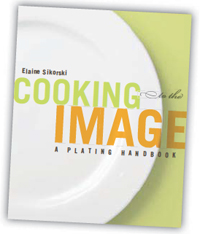As more foodservice professionals rethink the way they plate menu items, and with a proliferation of dinnerware choices, author Elaine Sikorski, CEC, CCE, has written a timely book. In Cooking to the Image: A Plating Handbook (Wiley, 2012), the Kendall College of Culinary Arts chef instructor shares ideas about how form and function translate to flavor and appearance on a plate. Here are some of her tips for building better plates, ideas she explores in depth in Cooking to the Image.
Menu: “The decision about dinnerware needs to be considered in terms of the menu. The menu is key in all decisions about plateware and plating.” Style: “While fashion is often dismissed as frivolous, it really should be considered as an artifact of culture. Beginning with the style represented by Auguste Escoffier, classical professional cuisine has had a number of styles in the modern era. Until the fusion style of professional cuisine, square plates were not even considered. Now, in global style, they are commonplace. One of the results of the square or rectangular plate is a different understanding of what makes a meal. Round plates were closely tied to the cultural understanding that a meal focused on a meat with side dishes. Rectangular plates, conversely, often have a non-distinct focus, representing a newer way of thinking about meals as small bites.”
Style: “While fashion is often dismissed as frivolous, it really should be considered as an artifact of culture. Beginning with the style represented by Auguste Escoffier, classical professional cuisine has had a number of styles in the modern era. Until the fusion style of professional cuisine, square plates were not even considered. Now, in global style, they are commonplace. One of the results of the square or rectangular plate is a different understanding of what makes a meal. Round plates were closely tied to the cultural understanding that a meal focused on a meat with side dishes. Rectangular plates, conversely, often have a non-distinct focus, representing a newer way of thinking about meals as small bites.”
Appropriateness: “A chef is a designer. While it is common practice to refer to our field as culinary art, I think it is much more appropriate to refer to it as culinary design. A designer works to solve a problem within a certain context that has a purposeful result. A chef, when selecting plateware, is trying to reconcile aesthetic considerations with the function of a menu.”
Practicality: “The plateware must not only fit the style of the restaurant, but also be durable and match the type of service. It must make it easy for the cooks to plate the food at the right temperature, the wait-staff to serve the food without mishap, and the customer to enjoy the food both visually and gustatorially.”
Viewing the plate as a palette
• See more Food Trends
0 comments
Hide comments




